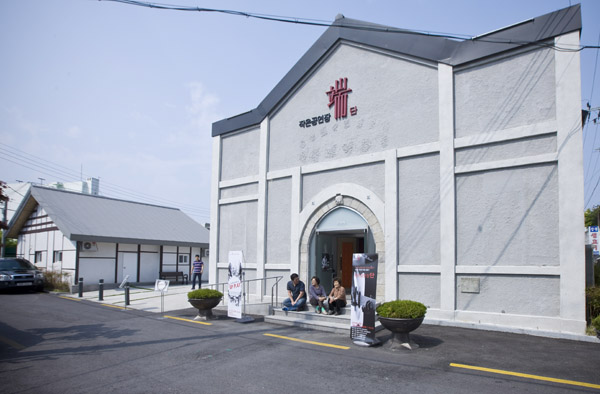Nation’s theaters going for smaller, cozier feeling

A small concert hall in Myeongneung-dong of Gangneung, Gangwon. By Kwon Hyuk-jae
From 2010 to last year, 83 new theaters have opened in Seoul, and more than half of them, 52, are venues with fewer than 300 seats. On the contrary, only four theaters with more than 1,000 seats, such as the D-Cube Arts Center, opened in 2011.
The situation is similar throughout Korea. Among 12 venues opened in the past three years in Busan, only one has more than 300 seats.
More than half of the new theaters in Daegu, Incheon and Daejeon have fewer than 300 seats, based on a report by the JoongAng Ilbo.
Experts say that small theaters can be compared to capillaries while large theaters, including the Seoul Arts Center and the Sejong Center for the Performing Arts are arteries, as the latter led the country’s cultural scene from the 1980s to 1990s.
“Theaters should have some human atmosphere, but people have a hard time getting the feeling in a large venue decorated with marble,” said Yoon Hak, president of White Hall in Seocho, southern Seoul, which opened in 2009 with 230 seats.
“Small theaters are getting popular as audiences prefer to be close to performers.”
According to a survey done by Seoul City Government’s policy development institute last year, 36.5 percent of 1,000 Seoulites prefer to go to small theaters in their neighborhood, while only 4 percent answered that they prefer large venues.

“The Culture Ministry’s policy to make one town have one theater is almost completed, but still Seoul and the metropolitan area lack in entertainment venues,” said Professor Lee Seung-yeop of Korea National University of Arts.
“The demand [from audiences] that large venues cannot fill up is being fulfilled by small-size theaters.”
Many local businesses have contributed to this trend.
LIG Arts Foundation, a cultural arm of LIG Group, led the effort to build LIG Art Hall in Hapjeong-dong in northwestern Seoul.
Perigee Hall, which can hold about 200 people, was constructed in the basement of a cell phone parts manufacturer.
Ahn Ho-sang, president of the National Theater of Korea, said that local companies have started building theaters as others have taken steps to foster cultural projects.
“After the arrival of LG Art Center [by LG Group], Samsung and other conglomerates followed suit and even small- and medium-sized companies are rolling up their sleeves to construct theaters,” he said. Samsung Group operates Blue Square Hall in Hannam-dong, central Seoul.
“Having a theater is like a popular trend among companies recently,” Ahn said.
These small theaters are also having a successful run. Dan, a theater in Gangneung, Gangwon, which opened in July last year, has focused on having classical music or jazz concerts. More than 70 percent of the tickets are sold whenever it holds a concert in the 150-seat venue.
The work is done by only two employees, including Baek Hyun-tae, who plans the performances, and Park Seong-min, who manages the facility. The building is a renovated church which was built in the 1950s.
“There is demand for jazz and classical music even in the small towns outside of the big cities, so we are targeting some music aficionados,” said Baek, who studied music composition.
These small theaters make the most profit by not giving out free tickets. Busan Haeundae Cultural Center, which opened in 2007, focused on recruiting members. It gives discounts to members for exhibitions and performances it arranges so that it can have a guaranteed number of guests coming when it presents shows it produced. With the 1,500 members it has, the venue has filled 40 percent of the shows that it produced.
It even took on the challenge of directing an opera named “Haeundae.” Although some may say it is a reckless challenge as the theater spent 100 million won ($87,566) to open the opera in September, art director Kim Seong-mo believes that it will help the theater build name value in the industry.
“Theaters’ competitiveness comes from how well they can direct and produce a show,” said Kim.
“As we have accumulated our own database of performers since the opening, we don’t experience too much trouble to make an opera.”
BY KANG KI-HEON [summerlee@joongang.co.kr]










with the Korea JoongAng Daily
To write comments, please log in to one of the accounts.
Standards Board Policy (0/250자)